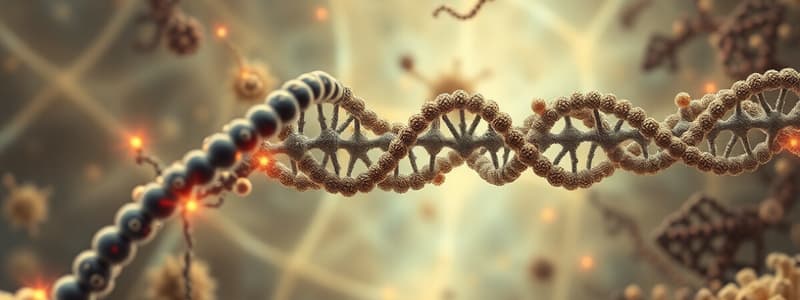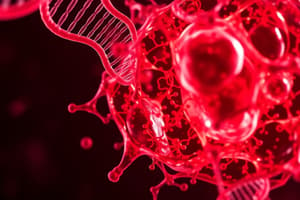Podcast
Questions and Answers
What is the primary function of telomerase in eukaryotic cells?
What is the primary function of telomerase in eukaryotic cells?
- To lengthen telomeres and prevent chromosome shortening (correct)
- To synthesize mRNA from DNA
- To initiate DNA replication
- To promote the degradation of chromosomes
Which statement accurately describes telomeres?
Which statement accurately describes telomeres?
- They are the ends of linear chromosomes, protecting genetic data. (correct)
- They are involved in initiating DNA replication.
- They are the mechanisms that hold sister chromatids together.
- They function as the sites for protein synthesis.
During transcription, what is synthesized?
During transcription, what is synthesized?
- RNA (correct)
- Amino acids
- DNA
- Proteins
In eukaryotes, where does transcription occur, and what follows this process?
In eukaryotes, where does transcription occur, and what follows this process?
Which of the following processes is directly involved in protein synthesis?
Which of the following processes is directly involved in protein synthesis?
Which statement about the central dogma is true?
Which statement about the central dogma is true?
Telomerase activity is essential for which of the following reasons?
Telomerase activity is essential for which of the following reasons?
Which of the following is NOT a function of DNA ligase?
Which of the following is NOT a function of DNA ligase?
During the transcription process in eukaryotes, which of the following occurs?
During the transcription process in eukaryotes, which of the following occurs?
Which statement correctly differentiates between the leading and lagging strands during DNA replication?
Which statement correctly differentiates between the leading and lagging strands during DNA replication?
Which of the following characteristics is NOT typical of prokaryotic DNA replication?
Which of the following characteristics is NOT typical of prokaryotic DNA replication?
What is the role of DNA ligase during DNA replication?
What is the role of DNA ligase during DNA replication?
The unwinding of DNA during replication is primarily facilitated by which enzyme?
The unwinding of DNA during replication is primarily facilitated by which enzyme?
Which of the following correctly describes the 5’ and 3’ ends of DNA?
Which of the following correctly describes the 5’ and 3’ ends of DNA?
In DNA structure, which base pairs with adenine?
In DNA structure, which base pairs with adenine?
What is the primary function of telomerase in linear chromosomes?
What is the primary function of telomerase in linear chromosomes?
Which of the following best describes the synthesis of the leading and lagging strands during DNA replication?
Which of the following best describes the synthesis of the leading and lagging strands during DNA replication?
What distinguishes prokaryotic DNA replication from eukaryotic DNA replication?
What distinguishes prokaryotic DNA replication from eukaryotic DNA replication?
Which of the following proteins keeps the DNA strands apart during replication?
Which of the following proteins keeps the DNA strands apart during replication?
What occurs at the replication fork during DNA replication?
What occurs at the replication fork during DNA replication?
Which statement about prokaryotic DNA polymerases is correct?
Which statement about prokaryotic DNA polymerases is correct?
Which of the following is FALSE regarding the DNA polymerase enzyme?
Which of the following is FALSE regarding the DNA polymerase enzyme?
Flashcards
DNA polymerase function
DNA polymerase function
DNA polymerase adds nucleotides to a DNA strand in the 5' to 3' direction. It needs a primer to start, and it has proofreading ability to ensure accuracy.
Eukaryotic vs. Prokaryotic Replication
Eukaryotic vs. Prokaryotic Replication
Eukaryotic DNA replication uses multiple origins of replication, while prokaryotic replication uses a single origin. This difference is crucial for replicating large eukaryotic genomes efficiently.
Leading and Lagging Strands
Leading and Lagging Strands
The leading strand is synthesized continuously in the same direction as the replication fork, while the lagging strand is synthesized in short fragments (Okazaki fragments) in the opposite direction.
DNA ligase role
DNA ligase role
Signup and view all the flashcards
Single-strand DNA binding proteins
Single-strand DNA binding proteins
Signup and view all the flashcards
DNA replication: direction
DNA replication: direction
Signup and view all the flashcards
Okazaki fragments
Okazaki fragments
Signup and view all the flashcards
DNA replication's need for a primer
DNA replication's need for a primer
Signup and view all the flashcards
Post-translational modifications
Post-translational modifications
Signup and view all the flashcards
Molecular chaperones
Molecular chaperones
Signup and view all the flashcards
Complementary Base Pairing
Complementary Base Pairing
Signup and view all the flashcards
DNA template strand
DNA template strand
Signup and view all the flashcards
Semiconservative Replication
Semiconservative Replication
Signup and view all the flashcards
Helicase
Helicase
Signup and view all the flashcards
Topoisomerase
Topoisomerase
Signup and view all the flashcards
Nucleotide Composition of DNA
Nucleotide Composition of DNA
Signup and view all the flashcards
Telomerase
Telomerase
Signup and view all the flashcards
Telomere
Telomere
Signup and view all the flashcards
What is NOT directly synthesized from a DNA template?
What is NOT directly synthesized from a DNA template?
Signup and view all the flashcards
Transcription
Transcription
Signup and view all the flashcards
Translation
Translation
Signup and view all the flashcards
What does the universality of the genetic code imply?
What does the universality of the genetic code imply?
Signup and view all the flashcards
Genotype vs. Phenotype
Genotype vs. Phenotype
Signup and view all the flashcards
What is an exception to the central dogma?
What is an exception to the central dogma?
Signup and view all the flashcards
Study Notes
DNA Replication and Gene Expression
- DNA Replication: A process where DNA is copied, crucial for cell division and maintaining genetic information.
- Eukaryotic Replication: Eukaryotes have multiple origins of replication on their chromosomes, in contrast to prokaryotes.
- Prokaryotic Replication: Uses one origin of replication.
- Leading Strand: Produced continuously in the 5' to 3' direction, following the replication fork.
- Lagging Strand: Synthesized discontinuously in short fragments (Okazaki fragments) moving away from the replication fork, and are joined by DNA ligase.
- DNA Polymerase: Enzyme that adds nucleotides during replication. It cannot start DNA synthesis independently and requires a primer.
- Telomerase: Enzyme that adds telomeric repeats to the ends of linear chromosomes, preventing loss of genetic material during replication.
- DNA Ligase: Enzyme that joins Okazaki fragments on the lagging strand.
- Single-stranded Binding Proteins: Maintain separate DNA strands for replication.
- Primase: Synthesizes RNA primers needed by DNA Polymerase for initiation.
- Helicase: Unwinds DNA double helix.
- Topoisomerases: Relieve the strain caused by unwinding of the double helix.
Gene Expression - Transcription and Translation
- Transcription: The process of using a DNA template to synthesize an RNA molecule, specifically mRNA.
- Initiation (Transcription): RNA polymerase binds to a promoter region on the DNA to begin transcription.
- Elongation (Transcription): RNA polymerase moves along the DNA template, synthesizing mRNA in the 5' to 3' direction.
- Termination (Transcription): RNA polymerase reaches a termination sequence, causing the release of the mRNA transcript.
- mRNA Processing (Eukaryotes only): Pre-mRNA undergoes processing with addition of a 5' cap and a poly-A tail, and splicing of introns to generate mature mRNA.
- Translation: The process of using mRNA to synthesize a polypeptide chain (protein).
- Ribosomes: Cellular structures where translation occurs.
- tRNA: Transfer RNA molecules that bring amino acids to the ribosome, matches to codons on the mRNA.
- Genetic Code: A set of rules that dictates which codons correspond to which amino acids.
- Codons (mRNA): Three-base sequences on mRNA that specify amino acids.
- Anticodons (tRNA): Three-base sequences on tRNA that are complementary to codons.
- Ribosomal Subunits: Two parts of Ribosomes (small and large) forming the complete ribosome.
- Initiation (Translation): The start codon on the mRNA binds to a ribosome
- Elongation (Translation): tRNA brings amino acids to the ribosome, and the ribosome forms peptide bonds.
- Termination (Translation): The stop codon on the mRNA signals the end of a polypeptide chain formation.
Genetic Mutations
- Point Mutation: A single base change.
- Missense Mutation: Changes a codon, resulting in a different amino acid.
- Nonsense Mutation: Changes a codon to a stop codon, leading to premature termination of translation.
- Silent Mutation: A codon change that does not affect the amino acid.
- Frameshift Mutation: Addition or deletion of a nucleotide, thereby shifting the reading frame of mRNA and producing an entirely different amino acid sequence that follows the alteration.
- Chromosomal Mutations: Major structural alterations in chromosomes, such as duplications, deletions, inversions, and translocations.
Other Key Terms
- Template Strand: The DNA strand used as a template for mRNA synthesis.
- Coding Strand: The DNA strand complementary to the template strand, same sequence as the RNA transcript, but contains uracil instead of thymine.
Studying That Suits You
Use AI to generate personalized quizzes and flashcards to suit your learning preferences.




